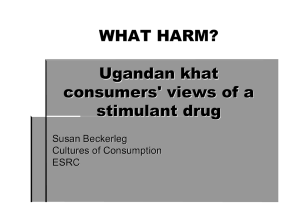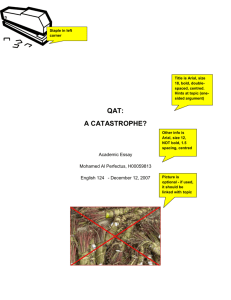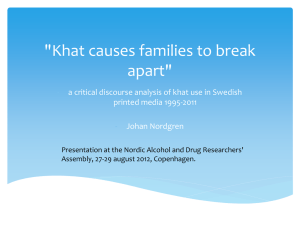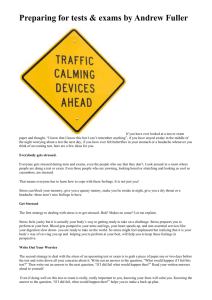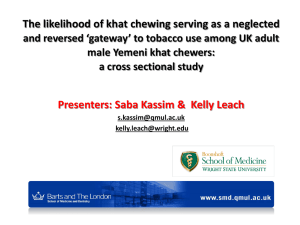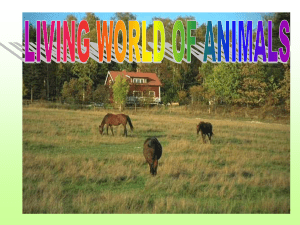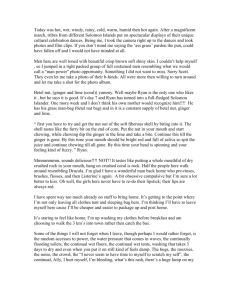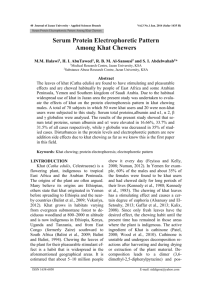What chew talking about? : How to spot betel quid and khat chewers
advertisement
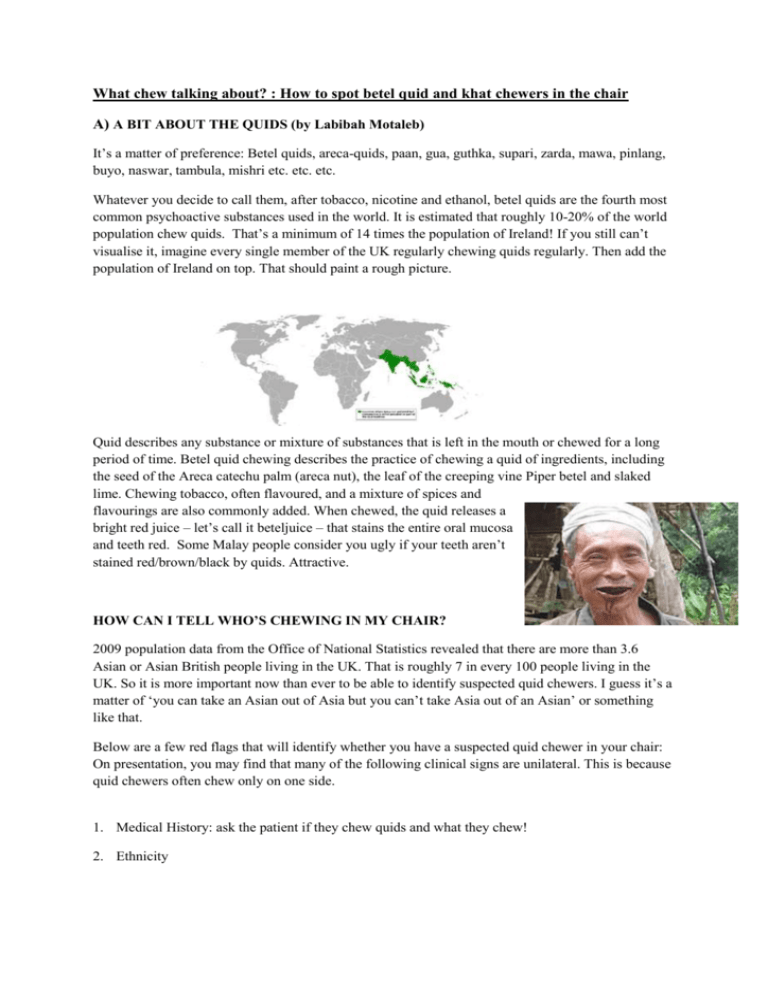
What chew talking about? : How to spot betel quid and khat chewers in the chair A) A BIT ABOUT THE QUIDS (by Labibah Motaleb) It’s a matter of preference: Betel quids, areca-quids, paan, gua, guthka, supari, zarda, mawa, pinlang, buyo, naswar, tambula, mishri etc. etc. etc. Whatever you decide to call them, after tobacco, nicotine and ethanol, betel quids are the fourth most common psychoactive substances used in the world. It is estimated that roughly 10-20% of the world population chew quids. That’s a minimum of 14 times the population of Ireland! If you still can’t visualise it, imagine every single member of the UK regularly chewing quids regularly. Then add the population of Ireland on top. That should paint a rough picture. Quid describes any substance or mixture of substances that is left in the mouth or chewed for a long period of time. Betel quid chewing describes the practice of chewing a quid of ingredients, including the seed of the Areca catechu palm (areca nut), the leaf of the creeping vine Piper betel and slaked lime. Chewing tobacco, often flavoured, and a mixture of spices and flavourings are also commonly added. When chewed, the quid releases a bright red juice – let’s call it beteljuice – that stains the entire oral mucosa and teeth red. Some Malay people consider you ugly if your teeth aren’t stained red/brown/black by quids. Attractive. HOW CAN I TELL WHO’S CHEWING IN MY CHAIR? 2009 population data from the Office of National Statistics revealed that there are more than 3.6 Asian or Asian British people living in the UK. That is roughly 7 in every 100 people living in the UK. So it is more important now than ever to be able to identify suspected quid chewers. I guess it’s a matter of ‘you can take an Asian out of Asia but you can’t take Asia out of an Asian’ or something like that. Below are a few red flags that will identify whether you have a suspected quid chewer in your chair: On presentation, you may find that many of the following clinical signs are unilateral. This is because quid chewers often chew only on one side. 1. Medical History: ask the patient if they chew quids and what they chew! 2. Ethnicity South Asian – The most common ethnic groups chewing quids in the UK include those from Bangladeshi, Indian, Pakistani and Sri Lankan origin, irrespective of age and gender. 3. Teeth Calculus deposits, mainly due to poor oral hygiene Long term continuous mechanical trauma leading to attrition, abrasion lesions, gingival recession and root fractures Erosion , from chemical substances released whilst chewing 4. Oral mucosa Red/brown/black stained teeth, oral mucosa and/or lips Mucosal sores due to mechanical trauma Betel Chewer's Mucosa: a brownish-red discoloured areca nut-encrusted change containing quid particles is often found where the quid particles are retained which are not easily removed, and with a tendency for desquamation and peeling. The underlying area assumes a wrinkled appearance. The lesion is usually localised to where the quid is retained Some patients will present with generally poor oral hygiene giving rise to gingivitis and periodontal disease in susceptible individuals. Halitosis Oral lichenoid lesions: fine wavy keratotic lines radiating from a erythematous focus Oral Submucous Fibrous (OSF) (chronic effect): mucosal ulcers, erythema, and vesicles, white thick striations of collagen in mucosa visible below the mucosal surface, trismus, intolerance to spicy food, speech difficulties and over time, the lips, soft palate, oesophagus, and the oropharynx are also affected. If you have found any of the above signs indicating your patient chews, the next logical question you may ask is: SO WHAT IF MY PATIENT CHEWS QUIDS? There are many consequences of long term quid-chewing. Unlike smoking and alcohol, the effects of chewing quids are unknown by many people, least of all by the people that chew them. So it is very important that you advise patients about the risks of continuing chewing, especially if they incorporate tobacco, areca nut and lime into their quids. There are two main branches of consequences: those to oral health, and those to general systemic health: 1. Oral health Oral squamous cell carcinoma Precancerous lesions including OSF, Leukoplakia, erythroplakia Caries Severe dental erosion, attrition and abrasion lesions, leading to complete loss of enamel of certain teeth Trismus Oral lichenoid lesions (resolve after cessation) Periodontal disease Areca-induced lichenoid lesions Keratosis 2. Systemic Cancer, hepatocellular carcinoma in particular Diabetes Cardiovascular disease, including abnormal heart rate and blood pressure Malnutrition due to poor diet Obesity Tolerance, dependence and addiction leading to withdrawal and oral cancer if not stopped. Neonatal withdrawal syndrome if quids are eaten during pregnancy Worsening of asthma The list is not exhaustive; there are many other effects that have not been researched yet. In fact, research into betel quids is an area that is relatively new and emerging in western world conducted research. B) KHAT (by Sagal Arwo). An 80 million pound industry, a legal drug delivering a ‘natural high’, an import of nearly 60 tons a week in Britain.. They call it Catha Edulis, or simply- KHAT. Khat has a HUGE oral manifestation and is used by a significant amount of the population. It would therefore be wise to get familiar with the ‘how to’ on identifying a chewer in order to help us successfully advice and treat our patients. So, first things first. WHAT IS KHAT? Khat is the evergreen shrub of the Celastraceae tree native to the Horn of Africa and the Arab Peninsula. Khat has a long traditional use as a stimulant in Somali, Yemeni and Ethiopian cultures. Fresh leaves are chewed and kept in the lower buccal vestibule for about 3 hours causing a characteristic bulge in the chewer, very similar to a hamsters pouch. The saliva and leaf slurry are then habitually swallowed and partially expectorated. Chewing khat leaves is a social habit in Yemen and many parts of East Africa. People chew fresh khat daily A large part of social gatherings such as weddings and funerals usually involve chewing khat. Apparently, it enhances social interactions! A chewing session lasts about 6 hours over one or two bundles of khat - a good work out for those muscles of mastication! Khat chewing is exacerbated by other activities which usually take place within these gatherings such as tobacco smoking and the drinking of sugary drinks. SO, WHAT’S THE PROBLEM? Khat chewing induces a state of euphoria and elation with feelings of increased alertness and arousal. This is followed by a stage of vivid discussions, loquacity and an excited mood later replaced by unease, depression, anxiety, irritability and insomnia. These effects are mainly attributed to cathinone and cathine, the principal psycho active compounds which are responsible for its psychological effects. These are potent stimulants of the central nervous system acting via dopaminergic and serotonergic pathways of the brain to cause euphorigenic and psychostimulant effects which are similar to the amphetamines. Both these stimulants are Class C controlled substances in the UK under the UK Misuse and Drugs Act of 1971 Orally, khat has many detrimental effects including the periodontitis, stomatitis, temperomandibular joint problems, severe keratosis and ulceration. Furthermore, there is strong evidence linking the long term use of khat with an increase in oral malignancies. HOW CAN I TELL WHOS CHEWING IN MY CHAIR? Below are a few clinical signs which should help you in the identification of khat chewers. Many of these signs may be found to be unilateral as khat is predominantly chewed on one side of the mouth. 1. Ethnicity: Khat chewing is very prevalent amongst: • • • Somalis Yeminis Ethiopians 2. Extra Oral Examination • • Mydriasis TMJ problems 3. Intra oral examination I. Mucosal changes • • • • • • II. Periodontal status • • • • • • III. Mean gingival index lower on the chewing side compared with the non-chewing side. Shallowing of periodontal pockets without a decrease in inflammation and an increase in attachment. Existing periodontal disease may be exacerbated by khat containing pesticides that are cytotoxic to periodontal fibroblasts. Gingival recession greater on posterior lower dentition on the chewing side. Gingival bleeding Gingival recession Teeth • • • IV. Oral leukoplakia primarily on the buccal aspect of the lower gingiva, the alveolar mucosa and the lower mucobuccal fold on the chewing side. This is 83% more likely in chewers than in non-chewers. Oral mucosal pigmentation Severe frictional keratosis Stomatitis Squamous cell carcinomas Ulceration due to the hardness of the khat leaves and friction with the mucosal tissues Staining of the teeth adjacent to the site of chewing. Generalised attrition and abrasion of the teeth due to long term mechanical stress. Poor oral hygiene and consequentially calculus deposits and halitosis. Oral dryness Xerostomia – The development of severe xerostomia is well documented in abusers of amphetamine and its derivatives, such as methamphetamine, which are chemically similar to cathinone, considered to be the active component of khat. SO WHAT IF MY PATIENT CHEWS KHAT? Khat use has significant toxic effects on health. These effects are not widely known or understood by the majority of people, including those who chew khat. It is therefore imperative that patients are advised about the detrimental effects of the continued use of khat in order to maintain their oral and general health. Below is a non-exhaustive list of both the local (oral) and systemic effects of khat use. Research into this area is in its infancy and further studies are required in order to obtain a whole picture of the effects of khat. Oral Oral Squamous cell carcinoma Oral leukoplakia Plasma cell gingivitis Stomatitis Mucosal keratosis Caries Periodontitis Mucosal ulceration Xerostomia Tooth loss Dental erosion ( associated with the fizzy drinks which are usually consumed during chewing sessions) Temperomandibular joint problems Systemic Insomnia Constipation General malaise Impaired sexual potency in men Migraines Hyperthermia Anorexia Loss of apatite Hypomania Mydriasis Tachycardia Hypertension Addiction Depression Impaired motor co-ordination So, now you know how to spot betel quid and khat chewers and why you shouldn’t ignore them. Well done and happy discovering!

